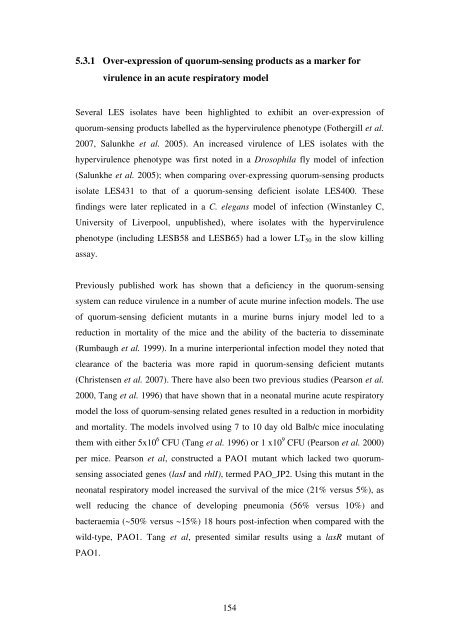5 The role of quorum-sensing in the virulence of Pseudomonas ...
5 The role of quorum-sensing in the virulence of Pseudomonas ...
5 The role of quorum-sensing in the virulence of Pseudomonas ...
You also want an ePaper? Increase the reach of your titles
YUMPU automatically turns print PDFs into web optimized ePapers that Google loves.
5.3.1 Over-expression <strong>of</strong> <strong>quorum</strong>-<strong>sens<strong>in</strong>g</strong> products as a marker for<br />
<strong>virulence</strong> <strong>in</strong> an acute respiratory model<br />
Several LES isolates have been highlighted to exhibit an over-expression <strong>of</strong><br />
<strong>quorum</strong>-<strong>sens<strong>in</strong>g</strong> products labelled as <strong>the</strong> hyper<strong>virulence</strong> phenotype (Fo<strong>the</strong>rgill et al.<br />
2007, Salunkhe et al. 2005). An <strong>in</strong>creased <strong>virulence</strong> <strong>of</strong> LES isolates with <strong>the</strong><br />
hyper<strong>virulence</strong> phenotype was first noted <strong>in</strong> a Drosophila fly model <strong>of</strong> <strong>in</strong>fection<br />
(Salunkhe et al. 2005); when compar<strong>in</strong>g over-express<strong>in</strong>g <strong>quorum</strong>-<strong>sens<strong>in</strong>g</strong> products<br />
isolate LES431 to that <strong>of</strong> a <strong>quorum</strong>-<strong>sens<strong>in</strong>g</strong> deficient isolate LES400. <strong>The</strong>se<br />
f<strong>in</strong>d<strong>in</strong>gs were later replicated <strong>in</strong> a C. elegans model <strong>of</strong> <strong>in</strong>fection (W<strong>in</strong>stanley C,<br />
University <strong>of</strong> Liverpool, unpublished), where isolates with <strong>the</strong> hyper<strong>virulence</strong><br />
phenotype (<strong>in</strong>clud<strong>in</strong>g LESB58 and LESB65) had a lower LT50 <strong>in</strong> <strong>the</strong> slow kill<strong>in</strong>g<br />
assay.<br />
Previously published work has shown that a deficiency <strong>in</strong> <strong>the</strong> <strong>quorum</strong>-<strong>sens<strong>in</strong>g</strong><br />
system can reduce <strong>virulence</strong> <strong>in</strong> a number <strong>of</strong> acute mur<strong>in</strong>e <strong>in</strong>fection models. <strong>The</strong> use<br />
<strong>of</strong> <strong>quorum</strong>-<strong>sens<strong>in</strong>g</strong> deficient mutants <strong>in</strong> a mur<strong>in</strong>e burns <strong>in</strong>jury model led to a<br />
reduction <strong>in</strong> mortality <strong>of</strong> <strong>the</strong> mice and <strong>the</strong> ability <strong>of</strong> <strong>the</strong> bacteria to dissem<strong>in</strong>ate<br />
(Rumbaugh et al. 1999). In a mur<strong>in</strong>e <strong>in</strong>terperiontal <strong>in</strong>fection model <strong>the</strong>y noted that<br />
clearance <strong>of</strong> <strong>the</strong> bacteria was more rapid <strong>in</strong> <strong>quorum</strong>-<strong>sens<strong>in</strong>g</strong> deficient mutants<br />
(Christensen et al. 2007). <strong>The</strong>re have also been two previous studies (Pearson et al.<br />
2000, Tang et al. 1996) that have shown that <strong>in</strong> a neonatal mur<strong>in</strong>e acute respiratory<br />
model <strong>the</strong> loss <strong>of</strong> <strong>quorum</strong>-<strong>sens<strong>in</strong>g</strong> related genes resulted <strong>in</strong> a reduction <strong>in</strong> morbidity<br />
and mortality. <strong>The</strong> models <strong>in</strong>volved us<strong>in</strong>g 7 to 10 day old Balb/c mice <strong>in</strong>oculat<strong>in</strong>g<br />
<strong>the</strong>m with ei<strong>the</strong>r 5x10 6 CFU (Tang et al. 1996) or 1 x10 9 CFU (Pearson et al. 2000)<br />
per mice. Pearson et al, constructed a PAO1 mutant which lacked two <strong>quorum</strong>-<br />
<strong>sens<strong>in</strong>g</strong> associated genes (lasI and rhlI), termed PAO_JP2. Us<strong>in</strong>g this mutant <strong>in</strong> <strong>the</strong><br />
neonatal respiratory model <strong>in</strong>creased <strong>the</strong> survival <strong>of</strong> <strong>the</strong> mice (21% versus 5%), as<br />
well reduc<strong>in</strong>g <strong>the</strong> chance <strong>of</strong> develop<strong>in</strong>g pneumonia (56% versus 10%) and<br />
bacteraemia (~50% versus ~15%) 18 hours post-<strong>in</strong>fection when compared with <strong>the</strong><br />
wild-type, PAO1. Tang et al, presented similar results us<strong>in</strong>g a lasR mutant <strong>of</strong><br />
PAO1.<br />
154














